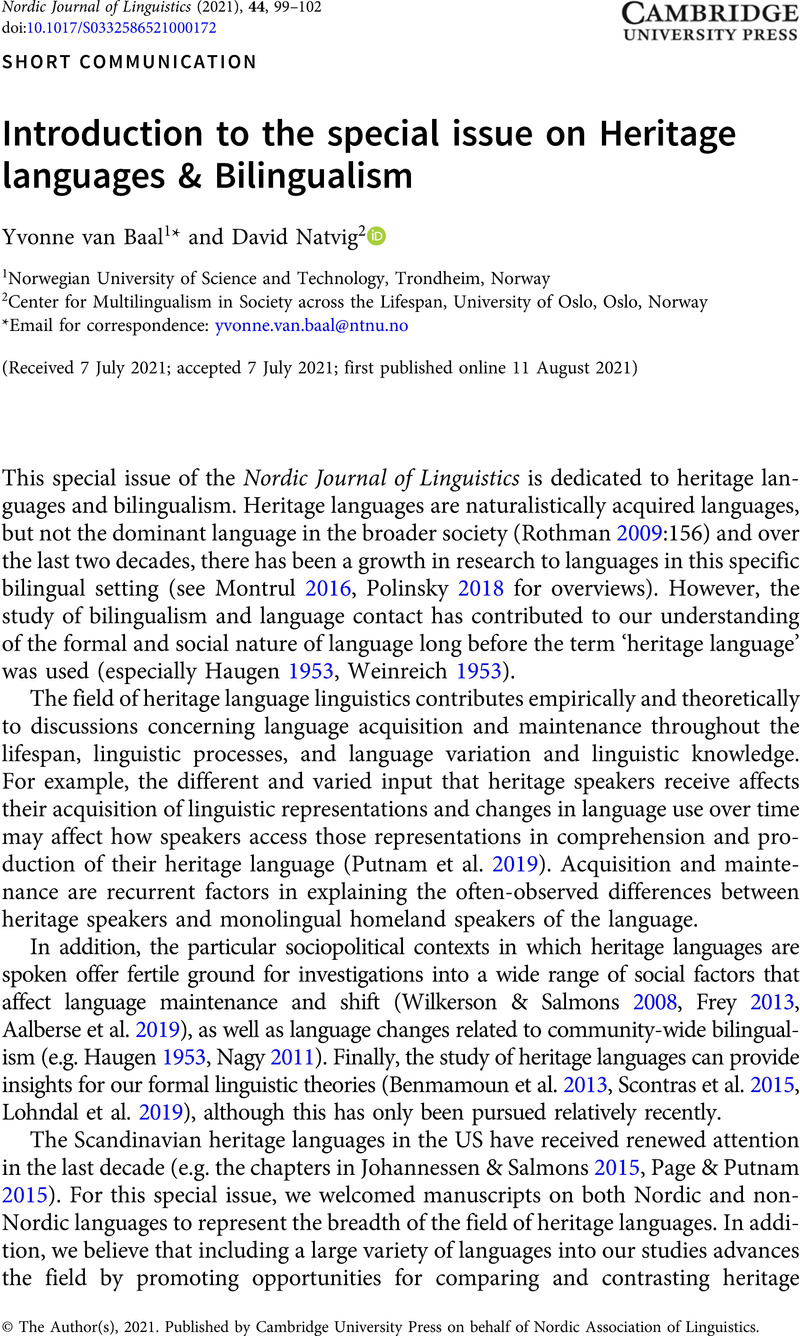No CrossRef data available.
Article contents
Introduction to the special issue on Heritage languages & Bilingualism
Published online by Cambridge University Press: 11 August 2021
Abstract
An abstract is not available for this content so a preview has been provided. Please use the Get access link above for information on how to access this content.

- Type
- Short Communication
- Information
- Nordic Journal of Linguistics , Volume 44 , Special Issue 2: Special Issue on Heritage languages & Bilingualism , October 2021 , pp. 99 - 102
- Copyright
- © The Author(s), 2021. Published by Cambridge University Press on behalf of Nordic Association of Linguistics
References
Aalberse, Suzanne, Backus, Ad, & Muysken, Pieter. 2019. Heritage Languages: A language contact approach. Amsterdam: John Benjamins.CrossRefGoogle Scholar
Benmamoun, Elabbas, Montrul, Silvina, & Polinsky, Maria. 2013. Heritage languages and their speakers: Opportunities and challenges for linguistics. Theoretical Linguistics 39, 129–181.CrossRefGoogle Scholar
Frey, Benjamin. 2013. Toward a unified theory of language shift: A case study in Wisconsin German and North Carolina Cherokee. Doctoral Dissertation, University of Wisconsin.Google Scholar
Haugen, Einar. 1953. The Norwegian Language in America. Philadelphia, PA: University of Pennsylvania Press.Google Scholar
Johannessen, Janne Bondi, & Joseph, Salmons, ed. 2015. Germanic heritage languages in North America: Acquisition, attrition and change. Amsterdam: John Benjamins.CrossRefGoogle Scholar
Lohndal, Terje, Rothman, Jason, Kupisch, Tanja, & Westergaard, Marit. 2019. Heritage language acquisition: What it reveals and why it is important for formal linguistic theories. Language and Linguistic Compass 13, 1–19.CrossRefGoogle Scholar
Montrul, Silvina. 2016. The Acquisition of Heritage Languages. Cambridge: Cambridge University Press.CrossRefGoogle Scholar
Nagy, Naomi. 2011. A multilingual corpus to explore geographic variation. Rassegna Italiana di linguistica applicata 43, 65–84.Google Scholar
Page, Richard B., & Putnam, Michael T., ed. 2015. Moribund Germanic Heritage Languages in North America: Theoretical perspectives and empirical findings. Leiden: Brill.CrossRefGoogle Scholar
Polinsky, Maria. 2018. Heritage Languages and Their Speakers. Cambridge: Cambridge University Press.CrossRefGoogle Scholar
Putnam, Michael, Perez-Cortes, Sylvia, & Sánchez, Liliana. 2019. Language attrition and the Feature Reassembly Hypothesis. In The Oxford Handbook of Language Attrition, ed. Monika, S. Schmid & Köpke, Barbara, 18–24. Oxford: Oxford University Press.Google Scholar
Rothman, Jason. 2009. Understanding the nature and outcomes of early bilingualism: Romance languages as heritage languages. International Journal of Bilingualism 13, 155–163.CrossRefGoogle Scholar
Scontras, Gregory, Fuchs, Zuzanna, & Polinsky, Maria. 2015. Heritage language and linguistic theory. Frontiers in Psychology 6, 1545.CrossRefGoogle Scholar
Scontras, Gregory, & Putnam, Michael T.. 2020. Lesser-studied heritage languages: An appeal to the dyad. Heritage Language Journal 17, 152–154.CrossRefGoogle Scholar
Weinreich, Uriel. 1953. Languages in Contact: Findings and Problems. New York, NY: Publications of the Linguistic Circle of New York.Google Scholar
Wilkerson, Miranda E., & Salmons, Joseph. 2008. “Good old immigrants of yesteryear” who didn’t learn English: Germans in Wisconsin. American Speech 83, 259–283.CrossRefGoogle Scholar





